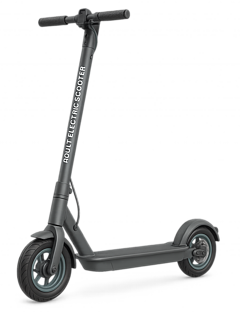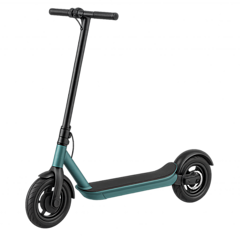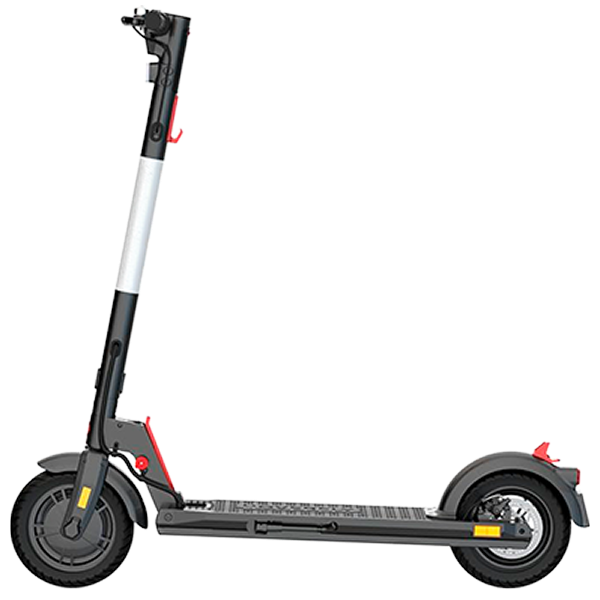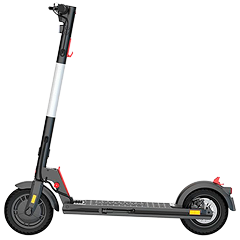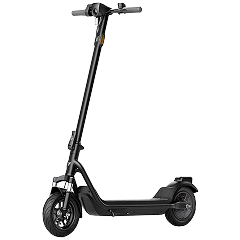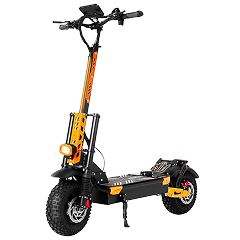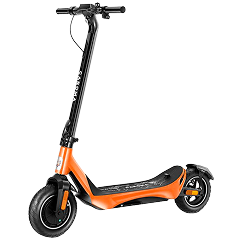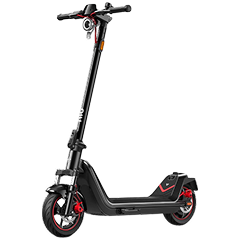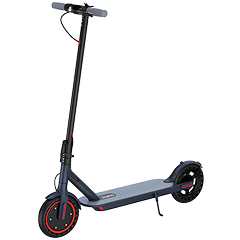Finding an electric scooter when you’re a bigger rider feels like shopping for shoes when you wear size 15. The options shrink fast, and what’s left often feels like an afterthought.
The good news, though, is that there are electric scooters designed with higher weight capacities (some up to 300 lbs or more). But you do need to know what to look for, because riding a scooter that’s struggling under your weight is about as fun as pedaling uphill with flat tires. Trust me, I’ve tested hundreds of scooters, and the difference between a scooter that’s built for you versus one that’s barely hanging on is night and day.
In this guide, we’ll break down the key factors heavier riders should consider, which are weight capacity, frame strength, motor power, battery range, suspension, brakes, and more. We’ll also explain why exceeding a scooter’s weight limit is a bad idea, and answer some common questions heavy riders have.
Just a word of advice before we dive in: if you’re a big, heavy rider, it’s better to stick to performance electric scooters. I know that sounds like I’m pushing you toward the expensive stuff, but hear me out. Performance scooters give you the best of everything without the machine struggling underneath you. You get actual acceleration, real hill-climbing ability, and components that last longer.
Quick Reference: Key Features for Heavy Riders
Below is a quick checklist of the key features and specs to look for when shopping for an electric scooter as a heavier adult. Use this table as a summary of everything we’ll cover:
If a scooter checks most of these boxes, it’s probably designed with heavy riders in mind, even if the marketing doesn’t say so.
What to Check on Electric Scooters for Heavy Riders
Shopping for a scooter when you’re carrying extra weight means paying attention to details that lighter riders can ignore. Here’s what you need to zero in on to find a scooter that’ll work for your weight range.
Weight Capacity (Max Rider Weight)
Every scooter comes with a maximum rider weight plastered on the spec sheet. This is the absolute ceiling the manufacturer says their scooter can handle. For most standard models it’s around 220 lbs (100 kg), and for many performance models, it’s about 265 lbs (120 kg). Some heavy-duty scooters go up to 300 lbs or more.
But here’s what they don’t tell you in bold print: those performance specs they’re bragging about? The top speed, the range, the hill-climbing ability? Those were all tested with a rider weighing 165-175 lbs.
So when you see a scooter rated for 300 lbs with a claimed 40 mph top speed, that speed was achieved by someone who weighs about half the max capacity. As a heavier rider, you’ll see those numbers slide. You might only get maybe 60-70% of the advertised range and a lower top speed.
My rule of thumb is to aim for a scooter where you’re at 85% or less of the maximum load. If you weigh 250 lbs, look for scooters rated for at least 295 lbs. This buffer ensures the scooter isn’t straining at its absolute limit every time you ride.
Why is this important? Because riding at or beyond the max weight puts extra stress on the motor, battery, frame, and tires. You’ll likely experience slower performance, reduced range, and faster wear-and-tear on components if you overload a scooter.
In fact, pushing a scooter past its design limit can cause dramatic drops in speed and mileage as the motor has to work harder and the battery drains much faster. For both safety and longevity, it pays to stay within the recommended weight range. If you’re near 220 lbs (the common limit for many scooters), it’s worth moving up to a model that can handle 265 lbs, 300 lbs, or more, so the scooter isn’t operating at the edge of its capability.
And remember to account for any extra gear you carry (backpacks, etc.) in that weight total.
Size and Dimensions (Getting the Right Fit)
Electric scooter suitability for bigger riders depends heavily on dimensions. You need space to be comfortable, as cramped quarters make for miserable rides. I’ve seen too many heavy riders trying to make do with scooters designed for teenagers, and it’s painful to watch.
Deck Size
The deck is where you plant your feet, and size really matters here. A cramped deck forces you into awkward positions that’ll have your legs screaming after a few miles. A typical scooter deck might be around 17–18 inches long and 6–7 inches wide, which can feel cramped if you have big feet or want to stand with a shoulder-width stance. So, something in the range of 20 inches long by 8 inches wide should be your minimum target.
Why does this matter so much? A bigger deck distributes your weight better, gives you a more stable platform, and provides plenty of room to plant your feet without one heel hanging off. More surface area equals better weight distribution, which means less stress on any single point of the frame. Plus, you need room to shift your stance on longer rides. Standing in exactly the same position for 30 minutes gets old fast, and on a tiny deck, you’ve got nowhere to go.
In addition to length and width, consider deck strength and clearance. Quality scooters designed for heavy riders use reinforced decks with internal ribbing or thicker aluminum plates. Some even have steel reinforcement in high-stress areas. The difference is immediately obvious when you stand on them. A good deck feels solid as a rock, while a weak one feels like you’re standing on a diving board.
Ground clearance becomes even more critical when you add weight. Most scooters have 3-4 inches of clearance, but if the deck sags under your weight, you might be down to 2 inches or less. That’s scraping territory on any decent-sized bump. Look for scooters with at least 5 inches of clearance to start with, giving you a safety margin when the suspension compresses.
The deck surface matters too. You need serious grip, especially when you’re carrying more momentum. Look for decks with aggressive grip tape, not just painted texture. The grip tape should cover the entire standing area and wrap around the edges. Some premium scooters use replaceable grip tape, which is perfect since heavy riders tend to wear through it faster.
Some scooters feature a kickplate or extended platform at the back, which can add even more room or allow a comfortable staggered stance.
I’ve noticed that scooters with larger decks also tend to have better overall build quality. It’s like the manufacturers figure if you need a big deck, you probably need everything else beefed up too. The correlation isn’t perfect, but it’s strong enough to use deck size as an initial quality filter.
Handlebar Height & Width
Nothing ruins a ride faster than handlebars that force you to hunch over like you’re searching for dropped change. For heavier riders, proper ergonomics matter even more because poor posture puts extra stress on components and on your body.
The handlebars should hit somewhere between your waist and lower chest when you’re standing naturally on the deck. Too low and you’re hunched over, putting stress on your back and too much weight on the front wheel. Too high and the steering gets wonky, plus you lose leverage for control.
Width matters too. Narrow handlebars make the scooter feel twitchy and unstable, especially at speed. Look for bars at least 22 inches wide. Wider bars give you better leverage and control, which becomes crucial when you’re managing more momentum.
If the scooter you like has a narrow bar, sometimes riders install aftermarket wider bars, but it’s best if the scooter comes appropriately sized.
Some scooters offer adjustable handlebar height, which is a huge plus if you’re particularly tall or short. But watch out for adjustment mechanisms that feel flimsy. The last thing you want is handlebars that slowly sink during your ride or develop play in the adjustment joint.
Motor Power and Configuration
The power of a motor gets determined by voltage and watts. Voltage signifies the intensity at which electricity gets pushed through a motor. Typically, electric scooter motors are rated at 36V, 48V, 52V, 60V, 72V, and 84V. The higher the voltage, the greater the torque and acceleration. Think of voltage like water pressure, higher pressure means more force when you open the tap.
Watts determine the size of a motor and indicate how much power it can handle. The higher the watts, the greater the potential top speed. But bigger weight slows your acceleration because of increased rolling and air resistance. You might take longer reaching that top speed, if you reach it at all.
Anything below 500W will struggle for a bigger rider. Just being honest here. I’ve watched 350W scooters with heavy riders aboard, and it’s sad. They accelerate like a tired snail and hit the slightest incline like it’s Mount Everest. If you want to get the most as a heavy rider, go for something with at least 1000W nominal power. You’ll want something that still has power to take you up those hill inclines without making you get off and push.
The sweet spot for most heavy riders sits between 1000W and 2000W nominal power. This gives you enough grunt for decent acceleration, the ability to maintain speed up moderate hills, and some power in reserve for when you need it.
Dual motors are strongly preferred for heavy riders. The difference between single and dual motor setups is major when you’re carrying extra weight. Single motors work fine for lighter riders on flat terrain, but add some pounds and any incline, and you’ll be wishing for that second motor. Dual motors give you power to both wheels, better traction especially in wet conditions, significantly better hill climbing, and more responsive acceleration. They also spread the load between two motors, reducing strain and heat buildup in each one.
The Battery and Range
Hand-in-hand with motor power is the battery, specifically its capacity (measured in watt-hours, Wh). A larger battery doesn’t directly increase how much weight a scooter can carry, but it does determine how far you can go and how the scooter handles the load.
The increased weight of heavier riders directly impacts the efficiency of an electric scooter’s battery. The higher the load, the lower the range. For scooters to perform as intended, the batteries have to work harder to move that extra weight.
Although manufacturers list maximum range figures, these are often based on a lighter rider, flat terrain, perfect weather, and riding in the slowest setting. Every extra pound costs battery life. A 165 lb rider might get close to the advertised 30-mile range, but at 265 lbs, you’re looking at below 20 miles in the real world.
Hills are range killers too. What looks like a gentle slope to a car feels like a mountain to a scooter motor pulling extra weight. Headwinds? Weather conditions? Terrain? Riding Style? All reduce the range. Basically, take the manufacturer’s range claim, cut it by 40% for realistic heavy rider performance, then subtract more for challenging conditions. To get the best performance as a heavy rider, go for something with at least 600 Wh of battery capacity, though 1000 Wh or more is really where you want to be.
Yes, bigger batteries mean heavier scooters, but you’re already dealing with a substantial machine. Another 15 lbs for double the range is an easy trade-off. Some high-end scooters pack 2000 Wh or more, giving you 40+ miles of real-world range even as a heavy rider. That’s freedom from range anxiety.
Also consider battery voltage, which ties into power output. High-voltage systems (52V, 60V, etc.) deliver power more efficiently, which can help maintain performance under load.
Braking
More weight means more momentum, and momentum is not your friend when you need to stop quickly. That electric scooter doing 25 mph with a 250 lb rider has way more kinetic energy than the same scooter with a 150 lb rider. Your brakes need to handle that extra energy reliably, repeatedly, without fading or failing.
For riders over 220 lbs, dual brakes are non-negotiable. You need independent front and rear braking with at least one mechanical brake, not just electronic regenerative braking. Here’s how the different brake types stack up for heavy riders:
Hydraulic disc brakes are the gold standard, offering powerful, consistent stopping force with low maintenance. They self-adjust as the pads wear, resist fade during repeated hard stops, and give you excellent modulation so you can brake smoothly.
Mechanical disc brakes are a good second choice, though they need more frequent adjustment and don’t offer quite the same stopping power.
Drum brakes are enclosed and low-maintenance, which is a plus, but they can have slightly longer stopping distances and can fade when hot. Electric regen brakes (which slow the motor) are a nice supplement, but usually not sufficient alone to stop a heavy rider quickly from higher speeds.
So, going by that, the best-case scenario is dual disc brakes, especially hydraulic disc brakes, which give you maximum stopping power with minimal effort
The quality of brake components matters too. Bigger rotors dissipate heat better. Sintered brake pads last longer than organic ones. Good brake levers give you mechanical advantage.
Suspension Systems for Heavy Riders
Suspension becomes critical when you’re a heavier rider. Your extra weight already compresses suspension more than lighter riders, so you need systems with enough travel and adjustability to work properly. A suspension system that’s already bottomed out just supporting your static weight can’t absorb bumps, it’s just decoration at that point. You want real suspension front and rear, with enough travel to work. At least 2-3 inches of travel is good, more is better.
Spring suspension is the simplest and most common type. It’s reliable and doesn’t need much maintenance, but basic springs often can’t handle heavy riders well. They’ll compress too much under your weight, leaving no travel for actual bump absorption. Look for scooters with adjustable spring preload so you can dial in the right setting for your weight.
Hydraulic suspension offers better damping control. Instead of just bouncing on springs, hydraulic dampers control how fast the suspension compresses and rebounds. This gives a much more controlled, comfortable ride. Some systems offer adjustment for both compression and rebound damping, letting you fine-tune the feel.
Air suspension provides the most adjustability since you can simply add more air pressure for more support. The downside is more maintenance as air shocks need periodic pressure checks and can develop leaks. But for heavy riders who want the best ride quality, adjustable air suspension is hard to beat.
Tires and Their Impact
Tires make a bigger difference than most people realize, especially for heavy riders. You’re putting more load on those contact patches, so tire construction and pressure become critical.
Pneumatic (air-filled) tires are strongly preferred over solid tires for heavy riders. They provide crucial shock absorption, better traction especially in wet conditions, lower rolling resistance, which helps with range, and the ability to adjust pressure for your weight.
The downside of pneumatic tires is flat potential, but modern tubeless tires with sealant inside handle most punctures automatically. The sealant plugs small holes instantly, and you might not even notice you picked up a nail. For heavy riders, I recommend adding extra sealant beyond what comes stock.
Tire pressure also matters more when you’re heavy. Under-inflated tires create excessive rolling resistance, killing your range and making the motor work harder. They also wear unevenly and are more prone to pinch flats. Over-inflated tires give a harsh ride and less traction. Check pressure weekly and adjust based on your weight. You’ll likely need higher pressure than what’s printed on the sidewall.
Tire size affects ride quality dramatically. In general, bigger is better when it comes to scooter tires for heavy riders. Larger diameter wheels (10 inches and up) roll over bumps more easily and improve stability at speed. They also typically have higher load ratings. Similarly, a wider tire (around 3 inches or more) offers a larger contact patch with the ground, which can handle weight more effectively and provide better grip. You’ll find that many heavy-duty scooters come with 10″x3″ tires or thereabouts for this reason
Build Quality
The scooter’s frame (including the stem, folding mechanism, and deck structure) needs to be rock solid. Extra weight will amplify any weakness for example, a wobbly stem or creaky joint under a 170 lb rider could outright fail under a 270 lb rider over time.
Scooters with higher weight capacities generally use stronger materials and reinforcements. Look for frames made of high-grade aluminum alloys or steel. Aluminum is common for its strength-to-weight ratio, and quality scooters often use 6061 or 7075 aluminum which is aircraft-grade and quite strong.
Steel can also be found in some heavy-duty models (or at least steel reinforcements in critical areas) because it’s very durable, though it makes the scooter heavier. Avoid anything with significant plastic components in load-bearing areas.
Check if the scooter has additional supports – e.g., dual-stem designs, beefier folding clamps, or extra welds/brackets in the chassis. These indicate it’s built to handle more stress.
Also consider that a scooter built for heavy adults will itself often weigh more. Lightweight scooters (say under 40 lbs) typically have thinner construction and are geared toward portability, not max strength. As a result, they usually cap out at lower weight limits. Don’t be alarmed if the ideal scooter for you weighs 50, 60, or even 100 lbs, as that often correlates with a tougher build and higher capacity. The trade-off is portability (lifting a 60 lb scooter is no joke), but if you need durability, expect a heavier frame.
Build quality also extends to things like the stem locking mechanism and handlebars. Look for reinforced deck-to-stem connections, as this is a common failure point. I’ve seen too many scooters where this joint develops play after a few months of heavy rider use. The tubing should be thick-walled, not the thin stuff that dents if you breathe on it wrong. Tap on the frame – quality metal has a solid ring to it, while cheap stuff sounds tinny.
Pay special attention to the folding mechanism if the scooter has one. It should lock solidly with zero play or movement. Give it a good shake when locked, any movement or creaking is a red flag. When locked upright, the stem should have minimal wobble.The stem needs to be rock-solid with no flex under load. I test this by gripping the handlebars and trying to flex them forward and back. Good stems don’t budge.
Check the welds too. Quality welds look smooth and consistent, like toothpaste squeezed evenly along the joint. Bad welds look like someone splattered metal randomly or have obvious gaps and porosity.
What Happens If You Overload Your Electric Scooter?
Here are the main consequences of overloading an electric scooter:
Sluggish performance
The scooter will accelerate slowly and may not reach its advertised top speed. The motor is working overtime to overcome the extra load, so you’ll feel a serious lack of power, especially on inclines. Hills that a properly loaded scooter could handle might become un-climbable when overloaded.
Reduced range
As mentioned, more weight = more strain on the battery. If you exceed the limit, expect your range to drop dramatically. You could easily lose 20–40% (or more) of the expected mileage. The battery will also run hotter and experience greater stress, which over the long term can shorten its lifespan.
Component wear and damage
Overloading puts excess wear on almost every part , the motor can overheat, tires can deform or get flats more easily, brakes will wear down faster trying to stop the extra momentum, and the suspension (if any) may bottom out frequently. Frames develop stress fractures, especially around welds and connection points.
These often start as hairline cracks you can barely see, then suddenly fail catastrophically. Wheel bearings fail from the side loads. Folding mechanisms develop play and eventually fail. Manufacturers set weight limits partly to avoid these failures; beyond the limit, you’re in uncharted (and unsafe) territory.
Stability and safety issues
A scooter handling an overload often feels less stable. The balance can be off, steering might wobble, and braking distances increase, which is dangerous. There’s also a higher risk of catastrophic failure (e.g. the stem snapping or the axle breaking) which could cause an accident.
Voiding warranty
Practically all manufacturers will consider the warranty void if you’re proven to ride over the limit. If something breaks and they suspect overloading, you likely won’t get a free fix.
FAQs
What is the Weight Limit of Most Electric Scooters
Can You Go Over the Weight Limit on an Electric Scooter
Does Weight Affect Electric Scooter Speed
High-powered scooters can compensate for this better, which is why they’re recommended for heavier adults. But even with massive motors, physics still applies. A 2000W dual motor electric scooter will still be slower with a 300 lb rider than a 150 lb rider when reaching top speed, it’ll just be less dramatic. Once you’re up to speed on flat ground, the difference shrinks. It’s the getting there that takes longer.


